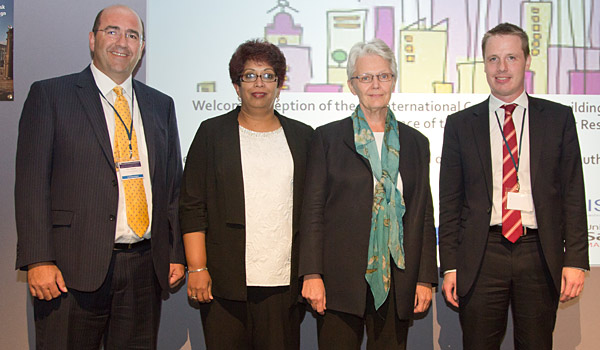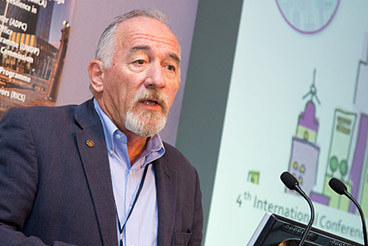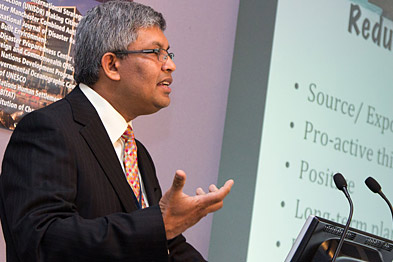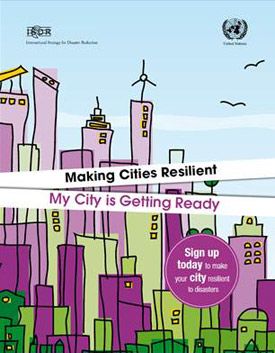4th International Conference on Building Resilience great success
 Pictured with Margareta Wahlström (second right), Special Representative of the Secretary-General of the United Nations for Disaster Risk Reduction are the University’s (l-r) Professor Mike Kaglioglou, Dean of Art, Design and Architecture, with Professors Dilanthi Amaratunga and Richard Haigh.
Pictured with Margareta Wahlström (second right), Special Representative of the Secretary-General of the United Nations for Disaster Risk Reduction are the University’s (l-r) Professor Mike Kaglioglou, Dean of Art, Design and Architecture, with Professors Dilanthi Amaratunga and Richard Haigh.
Fri, 19 Sep 2014 11:59:00 BST
Over 350 delegates weclomed to major conference
 TWO University of Huddersfield professors have hosted a conference that drew hundreds experts and researchers from around the world so that they could explore the best ways for society to cope with hazards and disasters.
TWO University of Huddersfield professors have hosted a conference that drew hundreds experts and researchers from around the world so that they could explore the best ways for society to cope with hazards and disasters.
The event was the 4th International Conference on Building Resilience and it was co-organised by the Global Disaster Resilience Centre, established at the University of Huddersfield and headed by Professors Richard Haigh and Dilanthi Amaratunga. They chaired the conference, held at Salford’s MediaCity.
The four-day event attracted more than 350 academics, researchers, practitioners and policy makers. There were four keynote addresses, which provided a global perspective and vision for disaster resilience research. They were given by Jerry Velasquez, who is Chief of the Advocacy and Communications Section and Head of the Making Cities Resilient Campaign of the UN Office for Disaster Risk Reduction; Dan Lewis (pictured above right), the Chief of Urban Risk Reduction, UN-Habitat, Kenya; Professor Siri Hettige, of the University of Colombo in Sri Lanka; plus Professor Janaka Ruwanpura (pictured above left), who is Vice-Provost (International), University of Calgary, Canada.
 The aim of the conference was to explore the concept of resilience as a useful framework of analysis for how society can cope with the threat of hazards, helping to understand the attributes that enable physical, socio-cultural, politico-economic and natural systems to adapt. Themes included the built environment, communication, disaster risk, healthcare facilities, plus governance and education in the wake of disaster.
The aim of the conference was to explore the concept of resilience as a useful framework of analysis for how society can cope with the threat of hazards, helping to understand the attributes that enable physical, socio-cultural, politico-economic and natural systems to adapt. Themes included the built environment, communication, disaster risk, healthcare facilities, plus governance and education in the wake of disaster.
The event incorporated the 3rd Annual Conference of the ANDROID Disaster Resilience Network. Backed by the EU’s ERASMUS programme, ANDROID has 68 partners across 38 countries and aims to promote co-operation and innovation among European Higher Education to increase society’s resilience to disasters of human and natural origin.
Making Cities Resilient campaign
 Like its predecessors in 2011 and 2013, the 4th International Conference on Building Resilience had strong links with the United Nations International Strategy for Disaster Reduction and its campaign named Making Cities Resilient: My City is Ready campaign.
Like its predecessors in 2011 and 2013, the 4th International Conference on Building Resilience had strong links with the United Nations International Strategy for Disaster Reduction and its campaign named Making Cities Resilient: My City is Ready campaign.
At the start of the conference, representatives of the 10 authorities which make up Greater Manchester, attended an official ceremony in which they to pledged their support to the Making Cities Resilient campaign.
Another dimension of the conference was that it hosted the 2014 meeting of the United Nations International Strategy for Disaster Reduction’s Making Cities Resilient campaign steering committee, plus the ANDROID residential doctoral school. This has 40 participants and aims to provide an interdisciplinary platform for doctoral candidates worldwide to harness and develop their capacity in disaster resilience.
Margareta Wahlström, Special Representative of the Secretary-General of the United Nations for Disaster Risk Reduction commented: “The 4th International Conference on Building Resilience came at an exciting time in global efforts to build resilient communities and a resilient planet. In the UK, dynamic public/private sector partnerships and a vibrant academia have contributed significantly to this international process.







